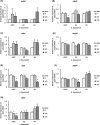Sub-minimum inhibitory concentrations of colistin and polymyxin B promote Acinetobacter baumannii biofilm formation
- PMID: 29554105
- PMCID: PMC5858813
- DOI: 10.1371/journal.pone.0194556
Sub-minimum inhibitory concentrations of colistin and polymyxin B promote Acinetobacter baumannii biofilm formation
Abstract
We investigated the numbers of planktonic and biofilm cells and the expression levels of genes encoding efflux pumps and biofilm-related proteins in 10 clinical isolates of multi-drug resistant Acinetobacter baumannii (MDRA) as well as in its standard strain ATCC 19606 in the presence of colistin (CST), polymyxin B (PMB), minomycin (MIN), and tigecycline (TGC) at their respective sub-MICs. The number of planktonic and biofilm cells of ATCC 19606 decreased in the presence of all aforementioned antibiotics in a dose-dependent manner. Cell number also decreased in two representative MDRA strains, R2 and R3, in the presence of MIN and TGC in a dose-dependent manner. In contrast, the number of biofilm cells in these two strains increased in the presence of CST, while they increased significantly in the presence of PMB in R2 only. Pearson correlation analysis revealed that the number of biofilm cells was positively and significantly correlated with the mRNA levels of genes encoding efflux pumps (adeB and adeG) and autoinducer synthase (abaI) in strain R2 and adeB, adeG, adeJ, poly-acetyl-glucosamine-porin (pgaA), and abaI in strain R3 in the presence of CST. It was positively and significantly correlated with the mRNA levels of genes encoding adeB in strain R2 and an outer membrane protein A (ompA) and biofilm-associated protein (bap) in strain R3 in the presence of PMB. These results provide valuable insights into the biofilm formation potency of clinical isolates of MDRA that depends on efflux pumps and biofilm-related genes and its regulation by antibiotics.
Conflict of interest statement
Figures



Similar articles
-
Biofilm Formation Caused by Clinical Acinetobacter baumannii Isolates Is Associated with Overexpression of the AdeFGH Efflux Pump.Antimicrob Agents Chemother. 2015 Aug;59(8):4817-25. doi: 10.1128/AAC.00877-15. Epub 2015 Jun 1. Antimicrob Agents Chemother. 2015. PMID: 26033730 Free PMC article.
-
Synergistic Inhibitory Effect of Polymyxin B in Combination with Ceftazidime against Robust Biofilm Formed by Acinetobacter baumannii with Genetic Deficiency in AbaI/AbaR Quorum Sensing.Microbiol Spectr. 2022 Feb 23;10(1):e0176821. doi: 10.1128/spectrum.01768-21. Epub 2022 Feb 23. Microbiol Spectr. 2022. PMID: 35196792 Free PMC article.
-
Contribution of RND superfamily multidrug efflux pumps AdeABC, AdeFGH, and AdeIJK to antimicrobial resistance and virulence factors in multidrug-resistant Acinetobacter baumannii AYE.Antimicrob Agents Chemother. 2025 Jul 2;69(7):e0185824. doi: 10.1128/aac.01858-24. Epub 2025 May 23. Antimicrob Agents Chemother. 2025. PMID: 40407309 Free PMC article.
-
Systematic Review of Antimicrobial Resistance of Clinical Acinetobacter baumannii Isolates in Iran: An Update.Microb Drug Resist. 2017 Sep;23(6):744-756. doi: 10.1089/mdr.2016.0118. Epub 2017 Jan 13. Microb Drug Resist. 2017. PMID: 28085571
-
Multidrug resistant Acinetobacter baumannii--the role of AdeABC (RND family) efflux pump in resistance to antibiotics.Folia Histochem Cytobiol. 2008;46(3):257-67. doi: 10.2478/v10042-008-0056-x. Folia Histochem Cytobiol. 2008. PMID: 19056528 Review.
Cited by
-
Effects of sub-inhibitory concentrations of meropenem and tigecycline on the expression of genes regulating pili, efflux pumps and virulence factors involved in biofilm formation by Acinetobacter baumannii.Infect Drug Resist. 2019 May 7;12:1099-1111. doi: 10.2147/IDR.S199993. eCollection 2019. Infect Drug Resist. 2019. PMID: 31190904 Free PMC article.
-
Novel colistin-EDTA combination for successful eradication of colistin-resistant Klebsiella pneumoniae catheter-related biofilm infections.Sci Rep. 2021 Nov 4;11(1):21676. doi: 10.1038/s41598-021-01052-5. Sci Rep. 2021. PMID: 34737361 Free PMC article.
-
AbOmpA in Acinetobacter baumannii: exploring virulence mechanisms of outer membrane-integrated and outer membrane vesicle-associated AbOmpA and developing anti-infective agents targeting AbOmpA.J Biomed Sci. 2025 May 27;32(1):53. doi: 10.1186/s12929-025-01147-5. J Biomed Sci. 2025. PMID: 40426208 Free PMC article. Review.
-
The multifaceted nature of antimicrobial peptides: current synthetic chemistry approaches and future directions.Chem Soc Rev. 2021 Jul 5;50(13):7820-7880. doi: 10.1039/d0cs00729c. Chem Soc Rev. 2021. PMID: 34042120 Free PMC article. Review.
-
A Systematic Study of the Stability, Safety, and Efficacy of the de novo Designed Antimicrobial Peptide PepD2 and Its Modified Derivatives Against Acinetobacter baumannii.Front Microbiol. 2021 Jun 18;12:678330. doi: 10.3389/fmicb.2021.678330. eCollection 2021. Front Microbiol. 2021. PMID: 34220763 Free PMC article.
References
-
- Fournier PE, Richet H. The epidemiology and control of Acinetobacter baumannii in health care facilities. Clin Infect Dis. 2006; 42(5): 692–699. doi: 10.1086/500202 - DOI - PubMed
-
- Munoz-Price LS, Weinstein RA. Acinetobacter infection. N Engl J Med. 2008; 358(12): 1271–1281. doi: 10.1056/NEJMra070741 - DOI - PubMed
-
- Dijkshoorn L, Nemec A, Seifert H. An increasing threat in hospitals: multidrug-resistant Acinetobacter baumannii. Nat Rev Microbiol. 2007; 5(12): 939–951. doi: 10.1038/nrmicro1789 - DOI - PubMed
-
- Peleg AY, Seifert H, Paterson DL. Acinetobacter baumannii: emergence of a successful pathogen. Clin Microbiol Rev. 2008; 21(3): 538–582. doi: 10.1128/CMR.00058-07 - DOI - PMC - PubMed
-
- Gordon NC, Wareham DW. Multidrug-resistant Acinetobacter baumannii: mechanisms of virulence and resistance. Int J Antimicrob Agents. 2010; 35(3): 219–226. doi: 10.1016/j.ijantimicag.2009.10.024 - DOI - PubMed
Publication types
MeSH terms
Substances
LinkOut - more resources
Full Text Sources
Other Literature Sources
Medical
Molecular Biology Databases

